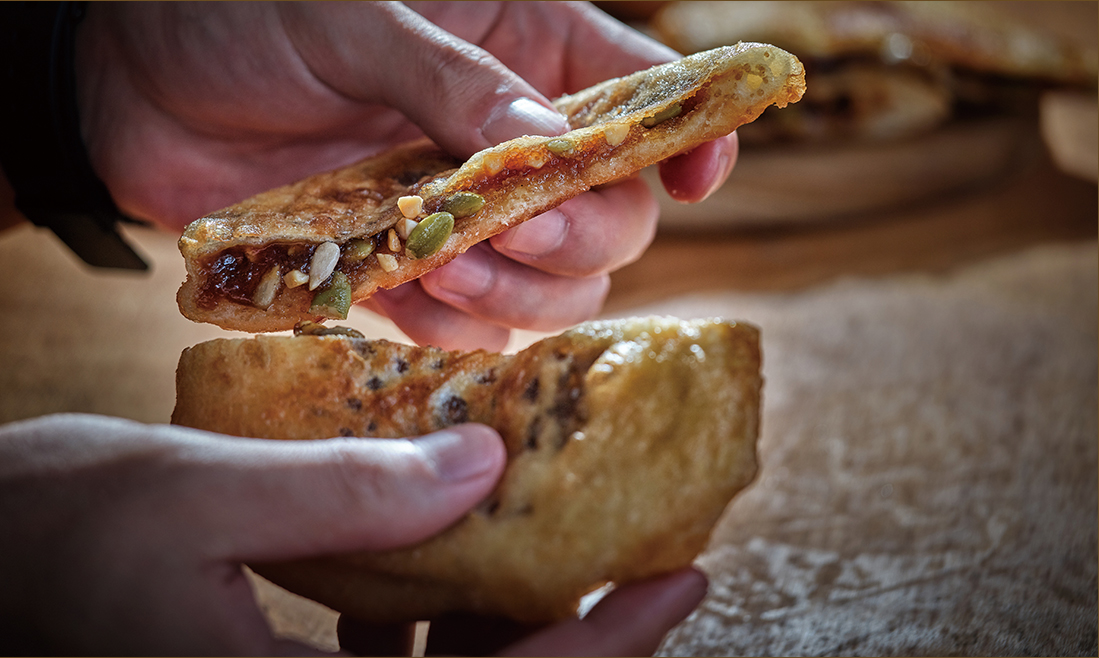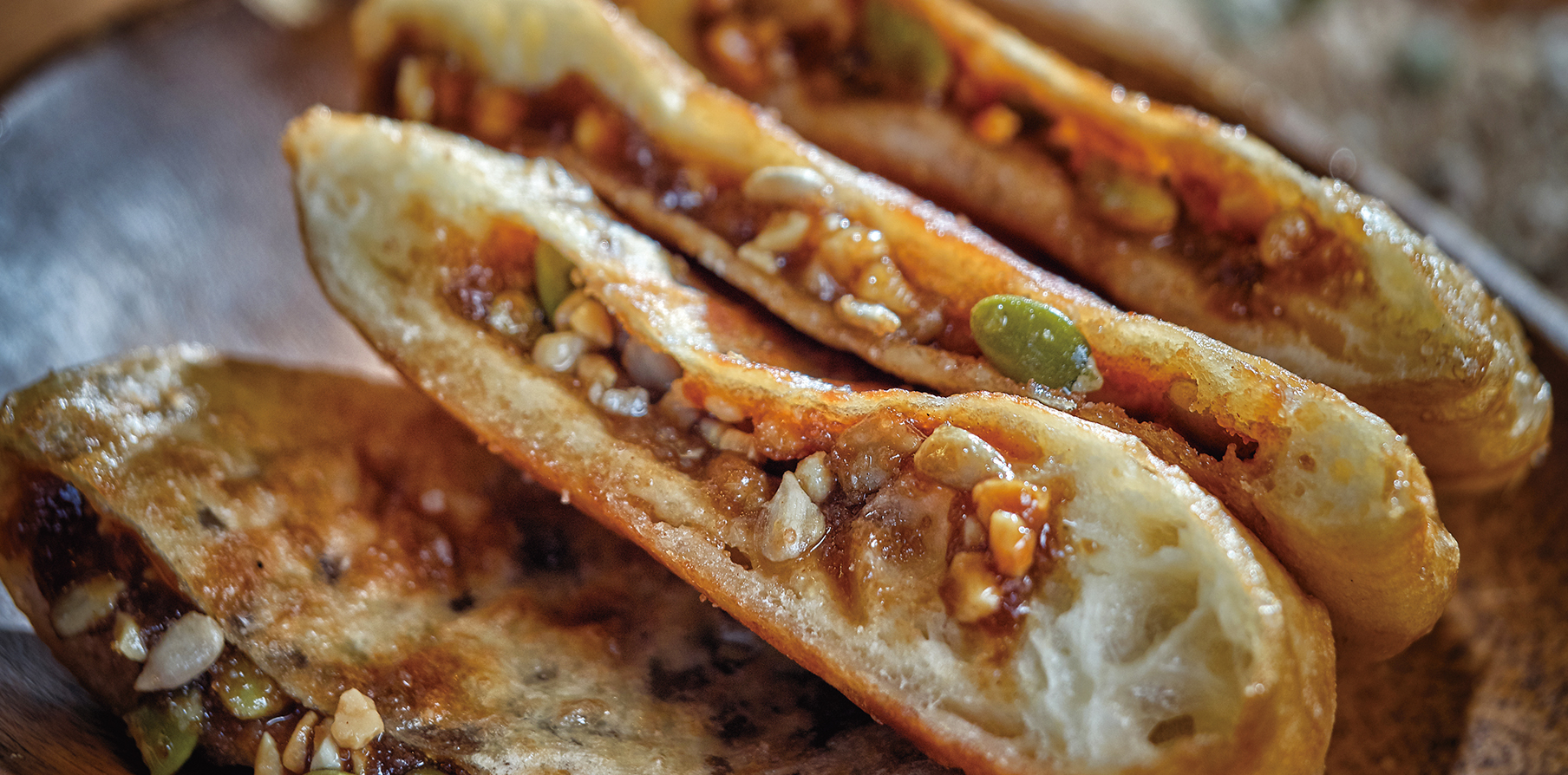Flavor
How Sweet
Hotteok
Hotteok (sweet pancake) is one of Korea’s most popular street snacks, especially in winter. Prepared with a generous amount of oil, the doughy and syrup-filled treat usually has brown sugar at its center but evolving culinary tastes have diversified the filling used to ingredients such as cinnamon, nuts and even kimchi.
Written by
• Kim Jane
Photographed by• Studio Kenn
Making hotteok requires shaping fermented flour dough into balls each filled with a spoonful of brown sugar or other fillings before frying them in a preheated pan. In winter, the snack’s appeal stems not only from the warm heat it emits after being made fresh but also its sweetness that seems to make the cold bearable.
Silk Road Origins
Hotteok is typically known to have gotten its first syllable from the onomatopoeia for the sound made to blow on hot food to cool, but the syllable is also said to come from a term indicating the Qing Dynasty of China. Although a nomadic Chinese merchant presumably brought hotteok to Korea, China is not considered the snack’s birthplace.
From 200 B.C. to A.D. 1,200-1,300, Chinese influence spread during the Han, Tang and Song dynasties largely due to the Silk Road, which allowed ceramics from the Chinese region to go west, as well as spices and foodstuffs from the Arab, Central Asian and Indian regions. Hotteok is believed to have simply passed through the Chinese region on its way toward Central Asia and eventually the Korean Peninsula.
Street Food Staple
After its arrival on the peninsula, hotteok is said to have been distributed by merchants and street vendors. Qing Dynasty soldiers dispatched to the Joseon Kingdom at the time of the Imo Incident, a violent uprising in 1882 in Seoul, remained in Korea after the incident since their homeland was not worth returning to. Instead, they made a living by selling simple snacks like mandu (dumplings) and hotteok, the latter of which gradually evolved to suit the Korean palate. Fillings like grain syrup, honey and brown sugar made the snack a hit among those with a sweet tooth. From Incheon, the traditional gateway to Korea back then and today, evolved forms of the treat made its way to Myeong-dong and Jongno-gu District, two adjacent regions in Seoul that were once populated by a large ethnic Chinese population.
True to its origins and enduring identity as a street food, hotteok is priced at KRW 1,000-3,500. The snack is usually sold by street kiosks called pojangmacha but brick-and-mortar storefronts also offer it as either a side dish or for takeout. In winter, passersby often hold folded hotteok in a paper cup, wrapped in an oil-proof napkin or stuck on a skewer.

Hotteok fillings range from honey, sunflower or other seeds and grains or a mix of them. / Hotteok is deep fried in sizzling oil. / Stores often use a wide commercial pan to prepare dozens of the sweet pancakes at once. © shutterstock
Constant Classic
The pan-fried version of hotteok, the most popular in Korea, debuted in 1970 with the introduction of cooking oil to the mass market; before then, the snack was made by roasting it in a fire pit or furnace. The Chinese versions of hotteok comprise hearty variants consisting of meat, chives and even seafood fillings.
Remaining consistent throughout ho- tteok’s history is its classic fillings. Crushed peanuts are said to have been mixed into sugar as a supplement to prevent the sticky liquid sugar from drooping. Variations tend to stay within a narrow category like hotteok with seeds, sunflower seeds or assorted nuts. Though several franchises and creative vendors have introduced spinoffs like those filled with cheese, vegetables or kimchi or those made with glutinous rice, the classic version remains the most popular by far.
Jeju Island’s specialty in this field is tangerine hotteok, given the numerous plantations there growing the nation’s best version of the fruit. The Nampo-dong neighborhood of Busan is where seed hotteok originated, and it later spread to the Seomyeon and Haeundae regions, two of the city’s major tourist hotspots. Korea’s No. 2 city is thus intimately tied to the emergence of seed hotteok, and some Koreans even consider it folk or ethnic food from the southern coastal city.
Other popular variants of the pastry include Samcheong-dong hotteok, which is named after the eponymous hip and trendy Seoul neighborhood, Namdaemun Gate hotteok and versions served in the provincial cities of Gunsan, Jeollabuk-do Province, and Cheongju, Chungcheongbuk-do Province.

Varieties of hotteok vary in thickness but all contain sweet and often hearty fillings.



















